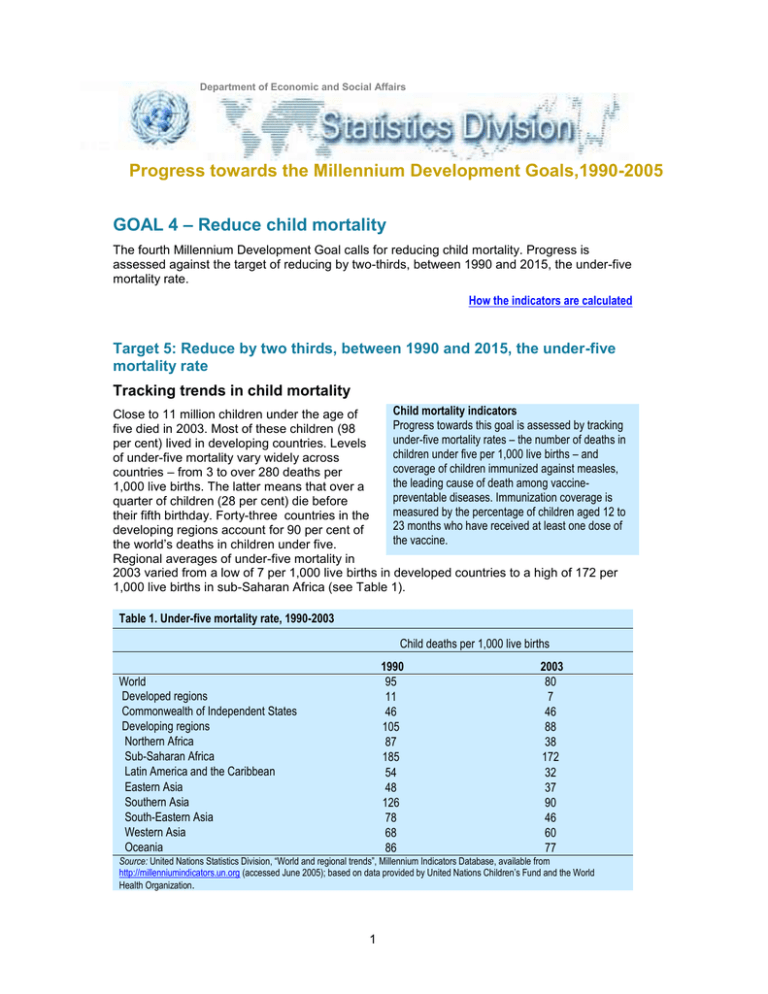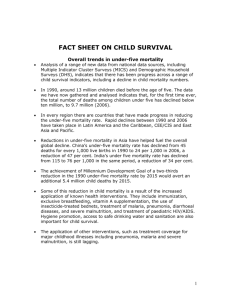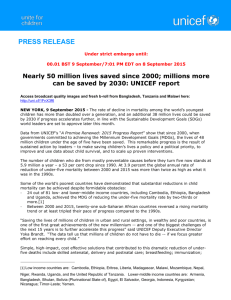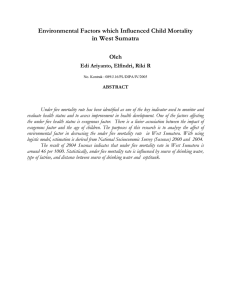Progress towards the Millennium Development Goals,1990-2005 – Reduce child mortality GOAL 4
advertisement

Department of Economic and Social Affairs Progress towards the Millennium Development Goals,1990-2005 GOAL 4 – Reduce child mortality The fourth Millennium Development Goal calls for reducing child mortality. Progress is assessed against the target of reducing by two-thirds, between 1990 and 2015, the under-five mortality rate. How the indicators are calculated Target 5: Reduce by two thirds, between 1990 and 2015, the under-five mortality rate Tracking trends in child mortality Child mortality indicators Close to 11 million children under the age of Progress towards this goal is assessed by tracking five died in 2003. Most of these children (98 under-five mortality rates – the number of deaths in per cent) lived in developing countries. Levels children under five per 1,000 live births – and of under-five mortality vary widely across coverage of children immunized against measles, countries – from 3 to over 280 deaths per the leading cause of death among vaccine1,000 live births. The latter means that over a preventable diseases. Immunization coverage is quarter of children (28 per cent) die before measured by the percentage of children aged 12 to their fifth birthday. Forty-three countries in the 23 months who have received at least one dose of developing regions account for 90 per cent of the vaccine. the world’s deaths in children under five. Regional averages of under-five mortality in 2003 varied from a low of 7 per 1,000 live births in developed countries to a high of 172 per 1,000 live births in sub-Saharan Africa (see Table 1). Table 1. Under-five mortality rate, 1990-2003 Child deaths per 1,000 live births 1990 95 11 46 105 87 185 54 48 126 78 68 86 World Developed regions Commonwealth of Independent States Developing regions Northern Africa Sub-Saharan Africa Latin America and the Caribbean Eastern Asia Southern Asia South-Eastern Asia Western Asia Oceania 2003 80 7 46 88 38 172 32 37 90 46 60 77 Source: United Nations Statistics Division, “World and regional trends”, Millennium Indicators Database, available from http://millenniumindicators.un.org (accessed June 2005); based on data provided by United Nations Children’s Fund and the World Health Organization. 1 Five diseases – pneumonia, diarrhoea, malaria, measles and AIDS – account for about 50 per cent of under-five deaths. Most of these lives could be saved by expanding coverage of existing interventions, especially among poor families. Malnutrition increases the risk of dying from these diseases and contributes to more than half of all child deaths. Figure 1. Causes of death in children under five, 2000-2003 AIDS 3% Other diseases and injuries 12% Measles 4% Malaria 8% More than half of these deaths are associated with malnutrition Diarrhoeal diseases (postneonatal) 17% Neonatal causes 37% Acute respiratory infections 19% Currently, almost 40 per cent of deaths in children under five occur in the first month of life. These deaths are closely related to the health of the mother and to the care provided to her at delivery. The most common cause of death is malnutrition of the mother and foetus, leading to low-birthweight babies. This is compounded by poor care during pregnancy and lack of skilled attendants at birth, including doctors, nurses or midwives. Table 2. Infant mortality rate, 1990-2003 Infants deaths per 1,000 live births 1990 64 10 39 71 66 110 43 37 87 54 53 63 World Developed regions Commonwealth of Independent States Developing regions Northern Africa Sub-Saharan Africa Latin America and the Caribbean Eastern Asia Southern Asia South-Eastern Asia Western Asia Oceania 2003 55 6 37 60 33 102 27 30 65 35 48 58 Source: United Nations Statistics Division, “World and regional trends”, Millennium Indicators Database, available from http://millenniumindicators.un.org (accessed June 2005); based on data provided by United Nations Children’s Fund and the World Health Organization. 2 Progress is uneven, with sub-Saharan Africa lagging behind Progress in reducing child mortality from 1990 to 2003, the last year for which comprehensive estimates are available, has been uneven. All regions, with the exception of the Commonwealth of Independent States (CIS), made some progress. Northern Africa, Latin America and the Caribbean, and South-Eastern Asia experienced steep declines, with under-five mortality dropping by more than 40 per cent, which put them on track to meet the MDG target. Improvements in socio-economic status, nutrition and access to prevention and treatment measures for major childhood diseases have helped drive improvements in child mortality in these regions. As with any averages, however, these regional statistics mask disparities among countries and among various socio-economic groups within a single country. Chart 1. Countries where more than 15 per cent of children die before age five Under-five mortality rate per 1,000 births, 2003 Sierra Leone 284 Niger 262 Angola 260 Afghanistan 257 Liberia 235 Somalia 225 Mali 220 Burkina Faso 207 Congo, Dem. Rep. of the 205 Guinea-Bissau 204 Rwanda 203 Chad 200 Nigeria 198 Côte d'Ivoire 192 Burundi 190 Mauritania 183 Zambia 182 Central African Republic 180 Malawi 178 Ethiopia 169 Cameroon 166 Tanzania, United Republic of 165 Guinea 160 Mozambique 158 Benin 154 Swaziland 153 Source: United Nations Statistics Division, “World and regional trends”, Millennium Indicators Database, available from http://millenniumindicators.un.org (accessed June 2005); based on data provided by United Nations Children’s Fund and the World Health Organization. 3 But the region with the highest level of child mortality, sub-Saharan Africa, experienced the smallest reductions over the 1990s – less than 1 per cent per year. In this region, under-five mortality must decrease by at least 8.5 percent annually over the next 12 years to achieve the global target. For a small number of sub-Saharan African countries, this lack of progress can be attributed to the increase in child deaths from AIDS. For most countries, however, advances in reducing child deaths have slowed because efforts to reduce malnutrition and provide appropriate interventions to address diarrhoea, pneumonia, vaccine-preventable diseases and malaria have been inadequate. Fragile health systems and socio-economic stagnation due to conflicts and instability have contributed to the lack of progress in the region. Forty-five per cent of all under-five deaths occur in sub-Saharan Africa. Major improvements in reducing the under-five mortality rate must occur in sub-Saharan Africa over the next few years if the target is to be met. This will require a rapid and dramatic increase in immunization coverage and other interventions that support families and communities in preventing disease and caring for their children. This includes improvements in health services, access to clean water and adequate sanitation facilities, relying exclusively on breast milk for the feeding of infants under 6 months of age, and increased access to treatment, such as antibiotics for pneumonia and appropriate drugs for malaria. Progress in Southern Asia will also have a significant impact on achievement of the goal, since a third of under-five deaths occur in that region. The average annual reduction in underfive mortality between 1990 and 2003 in Southern Asia was only 2.6 per cent. If this trend continues, the region will also fall short of meeting the MDG target by 2015. Countries affected by conflict, including Cambodia and Iraq, have seen no improvement or increases in mortality since 1990. Countries with high levels of HIV/AIDS, especially in Southern Africa, such as Botswana, Zimbabwe and Swaziland, have also seen increases in under-five mortality since 1990. Immunization against measles, one indicator of progress Despite the availability of a safe, effective and relatively inexpensive vaccine for over 40 years, measles remains a major cause of childhood mortality. Routine childhood immunization against measles is an effective way to reduce child deaths. It is also a proxy indicator of access to basic health services for children under five. Estimates of routine measles immunization coverage have shown slight improvements between 1999 and 2003, rising from 73 per cent to 77 per cent globally. Sub-Saharan Africa, the region with the lowest coverage in 1990, has seen the least progress – moving from 56 to 61 per cent. Coverage in this region will require substantial improvement if measles mortality is to be reduced in a sustainable manner. In Oceania, the percentage of children immunized against measles dropped significantly – from 70 to 57 per cent. A sharp decline also occurred in Eastern Asia.1 Since 1990, countries in the Commonwealth of Independent States, Latin American and the Caribbean and Southern Asia have made the most progress in expanding coverage. Less but steady progress has been made in Northern Africa and South-Eastern Asia. 4 Table 3. Percentage of children immunized against measles, 1990-2003 Percentage of children 12-23 months who received at least one dose of measles vaccine 1990 2003 World 73 77 Developed regions 84 92 Commonwealth of Independent States 85 97 Developing regions 71 75 Northern Africa 85 93 Sub-Saharan Africa 56 61 Latin America and the Caribbean 76 93 Eastern Asia 98 85 Southern Asia 58 69 South-Eastern Asia 71 79 Western Asia 80 84 Oceania 70 57 Source: United Nations Statistics Division, “World and regional trends”, Millennium Indicators Database, available from http://millenniumindicators.un.org (accessed June 2005); based on data provided by United Nations Children’s Fund and the World Health Organization. An agenda for change If current trends continue, according to UNICEF, the reduction in under-five mortality worldwide from 1990 to 2015 will be just 15 percent, well short of the two-thirds reduction goal. Yet, many of the therapies and medicines needed to combat childhood diseases exist. What is required is better access to them, coupled with systemic reform of health facilities and the delivery of care, especially in rural areas. In addition, appropriate preventive and care-seeking behaviours by mothers are essential. Opportunities to provide treatment outside of health facilities, while well accepted for diarrhoea, need to be further explored for pneumonia and malaria.2 Expanding known solutions can eliminate most child deaths In the series of studies on child mortality published by The Lancet3, five themes consistently emerge: 1) a small number of diseases and underlying biological factors are responsible for the large majority of childhood deaths; 2) existing interventions, if implemented in a way that reaches those who need them most, could prevent a substantial proportion of these deaths; 3) childhood mortality levels vary significantly not only across regions and countries, but even within countries, with differences determined by socio-economic inequities; 4) existing interventions can be implemented most effectively in those countries where health systems work best; 5) child health programmes in developing countries are largely under-funded – major new investments will be needed to achieve Millennium Development Goal 4. The severity of many childhood illnesses can be reduced, or eliminated altogether, through prevention and treatment. One of the study shows that with a set of interventions for which there is at least limited evidence of an effect, 60 per cent of the 10 million deaths in 2000 – that is, 6 million child deaths – could have been prevented in the 43 countries accounting for 90 per cent of child mortality. Among these life-saving interventions are breastfeeding, oral rehydration therapy, use of insecticide-treated mosquito nets to prevent malaria, use of complementary foods, use of antibiotics for the treatment of antenatal sepsis and for childhood pneumonias, and prevention of zinc deficiency. 4 Levels of coverage for these interventions are still unacceptably low in most low-income and middle-income countries. Worse still, coverage for some interventions, such as immunizations and attended delivery, are stagnant or even falling in several of the poorest countries. A review of coverage in the 43 countries where 90 per cent of child deaths occur shows that continued breastfeeding of infants aged 6-11 months was the only intervention to reach nearly all children. Measles vaccine was received by two thirds of children under 5 years, and all other interventions had 5 coverage of less than 60 per cent. Among 34 sub-Saharan African countries with endemic malaria, results of surveys between 1999 and 2004 showed that only 3 per cent of children slept under an insecticide-treated mosquito net the previous night. Comprehensive immunization against measles could have saved the lives of 2.3 million African children in the last decade, according to WHO and UNICEF estimates. 5 Indeed, countries that have adopted well-known strategies, including Botswana, Malawi, Namibia and South Africa, have nearly eliminated measles since 2000. 6 Diarrhoeal disease kills almost 2 million children in developing countries each year, 7 but it is well understood that protected drinking water, basic hygiene in the home and inexpensive oral rehydration solutions could reduce these numbers to a fraction of their present rates. Acute respiratory infections are another big killer, yet they too can be effectively treated with antibiotics. Breastfeeding all babies would save an additional 1.5 million lives each year, according to UNICEF.8 Improving the nutrition of mothers and basic health services, such as antenatal care and the availability of skilled birth attendants, would reduce infant deaths in the first week of life, which, in 2000, represented more than 20 per cent of under-five mortality. Increasing the ability of the poor to access health services to the same degree as the wealthier segments of society can provide major impetus toward achieving the MDG for child survival. In fact, if the under-five mortality rate in developing countries could be reduced to the under-five mortality rate for the richest 20 per cent of the population of those countries, the overall under-five mortality rate could be reduced by as much as 40 per cent. 9 Tackling specific diseases and the health system as a whole Acute respiratory infections, primarily pneumonia, kill over 2 million children under the age of five each year in developing countries.10 In total, they account for about 19 per cent of underfive mortality. Treatment with oral antibiotics can wipe out bacterial infections that are the primary cause of pneumonia in countries with high child mortality. 11 But a common problem for many poor families in developing countries is getting to health facilities in time, since young children can quickly succumb to these life-threatening infections. However, data from 29 countries show that fewer than half of children with acute respiratory infections are taken to health care providers. In West Africa, the problem is even more acute, with less than a third of children receiving outside help.12 Malaria kills over 1 million people a year, 90 per cent of them in sub-Saharan Africa. It is also a major source of lost productivity, with repeated infections forcing adults to leave the workforce for days or even weeks at a time. Pregnant women and their unborn children are particularly vulnerable to the disease, which is a leading cause of low birthweight in newborns, anaemia and infant death. Young children are also susceptible, since they lack the immunity that comes from repeated infections. In sub-Saharan Africa alone, more than 2,000 children a day die from malaria. Children who do survive do not escape unharmed. Episodes of fever and anaemia take a toll on their mental and physical development. This makes it even more important that children and pregnant women receive preventive measures as well as anti-malarial drugs if they develop the disease. A specific combination of medications can help where resistance to anti-malarial drugs is widespread. Insecticide-treated mosquito nets, especially in high-risk areas, are a critical preventive measure. In fact, trials in several countries have shown they can reduce childhood death rates from malaria by as much as 35 per cent. 13 Providing treatment with antiretroviral therapy can substantially reduce mother-to-child transmission of the virus, but these drugs are far from being available to all. The fact that women represent an increasingly large proportion of those infected with HIV makes it imperative that childcare be integrated into reproductive health services for mothers. Many sick children in poor countries suffer from not just one disease, but from several. For instance, inadequate food can increase the risk of respiratory and diarrhoeal infections, which in turn can lead to an increase in malnutrition. And children suffering from measles are particularly susceptible to pneumonia.14 6 An effective strategy to reduce child mortality needs to consider both the specific diseases that threaten children’s lives as well as the functioning of the health system as a whole. Many health systems in poor countries lack investment in rural areas, and their effectiveness is poorly monitored. For instance, in Cambodia, 85 per cent of the population lives in rural areas but only 13 per cent of government health staff lives there. In Angola, 65 per cent of the population is rural, but only 15 per cent of health professionals work outside of urban areas. 15 While such gaps are detrimental to the entire rural population, small children are at the greatest risk since they often require immediate treatment in order to survive. The lack of adequate incentives for health professionals is another problem that afflicts health systems in poor countries, along with absenteeism and lack of training.16 Translating current knowledge into effective action Community-based initiatives can extend the delivery of interventions in areas where health services are hard to access, but strengthening national health systems should be the longterm aim. At subnational levels, this will require adequate data to support health planning; regular monitoring of the provision and use of health services; and high coverage and equitable distribution of selected interventions. The Millennium Development Goal for child survival can be achieved, but only if strategies for delivering interventions are greatly improved and scaled-up.17 Translating current knowledge into effective action for child survival will require leadership, stronger health systems that reach poor children and their mothers, and targeted human and financial resources. 18 But even when these resources are lacking, a number of very poor countries have shown what can be accomplished through campaigns to educate families on better health practices. Mass media campaigns in Cuba on the importance of boiling water, immunization and breastfeeding helped to reduce child mortality rates despite an economic crisis and very low incomes. (In fact, even though Cuba’s gross national product per capita is less than one seventh that of the United States of America, its infant mortality rate is the same. 19) Other encouraging results have come from small-scale projects around the world. In two districts in the United Republic of Tanzania, for instance, social marketing directed to shop owners and the public-health sector was used to promote the distribution and use of insecticide-treated mosquito nets. As a result, the proportion of infants reported to have slept under a treated bed net rose from 10 per cent to 50 per cent in 3 years, leading to a 27 per cent reduction in mortality among children who used the nets.22 Notes The sharp decline seen in Eastern Asia, is most likely due to a change in methods in estimating immunization coverage in China. (The Ministry of Health in China has requested assistance in identifying alternative methods to determine a more accurate picture of coverage). 2 Millennium Project, Interim Report of Task Force 4 on Child and Maternal Mortality, available at: http://www.unmillenniumproject.org/html/tf4docs.shtm. 3 UNICEF, WHO and others have supported and contributed to a series of studies published in the medical journal The Lancet that explores the causes of child deaths, where they occur, what solutions can be applied, and the kinds of efforts needed to further reduce child mortality. The Lancet Child Survival Series, available at http://thelancet.com/journal/vol361/iss9376/child_survival 4 Ibid. 5 Global Alliance for Vaccines and Immunization, “Comprehensive immunization strategy can greatly reduce child deaths from measles”, press release (7 January 2003), available at http://www.who.int/vaccines/gavi/pr_20030103.shtml. 6 Ibid. 7 WHO Fact Sheet No.180, “Reducing mortality from major childhood killer diseases” (September 1997), available at www.who.int/child-adolescent-health/New_Publications/IMCI/fs_180.htm. 8 UNICEF, “Facts for life: breastfeeding”, available at http://www.unicef.org/ffl/04/index.html. 9 C. Victora, A. Wagstaff et al., “Child Survival IV. Applying an equity lens to child health and mortality: more of the same is not enough”, The Lancet 2003; 362:233-41. 1 7 UNICEF, The Progress of Nations 2000, available at http://www.unicef.org/pon00/ts10.htm. WHO, “WHO’s contribution to the report for the follow-up to the World Summit for Children. In preparation for the United Nations General Assembly Special Session for Children”, September 2001, p. 7. 12 UNICEF, “The Progress of Nations”, op cit. 13 WHO Fact sheet No.180 (Geneva). 14 WHO Fact sheet No.180 (Geneva). 15 S. Mehrotra and E. Delamonica, Public spending for the poor: basic services to enhance capabilities and promote growth (Oxford University Press, Oxford, forthcoming), cited in the United Nations Development Programme’s Human Development Report 2003, p. 99 (Oxford University Press, Oxford, 2003). 16 Devarajan et al. 17 J. Bryce, S. el Arifeen et al., “Child Survival III. Reducing child mortality: can public health deliver?” The Lancet 2003; 362:159-64. 18 The Bellagio study group on child survival, “Child Survival V. Knowledge into action for child survival”, The Lancet 2003; 362:323-27. 19 R. Garfield, Responding to Sanctions: Comparison between Iraq and Cuba, p. 8 (New York, Columbia University, 15 March 2003). 22 S. Devarajan and R. Reinikka, “Making Services Work for the Poor”, Finance and Development, p. 48 (September 2003). 10 11 How the indicators are calculated Under-five mortality rate The under-five mortality rate is the probability (expressed as a rate per 1,000 live births) of a child born in a specified year dying before reaching the age of five if subject to current agespecific mortality rates. The best source of data for calculating child mortality rates is a complete vital registration system – one covering at least 90 per cent of vital events in the population. However, in developing countries, vital registration is often unreliable and incomplete. Estimates must be obtained from sample surveys or derived by applying indirect estimation techniques to registration, census or survey data. Different household surveys, including the Multiple Indicator Cluster Survey and the Demographic and Health Survey, are used. The United Nations Population Division, UNICEF, WHO and the World Bank regularly produce estimates of under-five mortality based on available national data. These estimates, however, may differ as a result of different methodologies used as well as differences in timing for the production and reporting periods of the estimates. Estimates presented in this report were provided by UNICEF. 8




